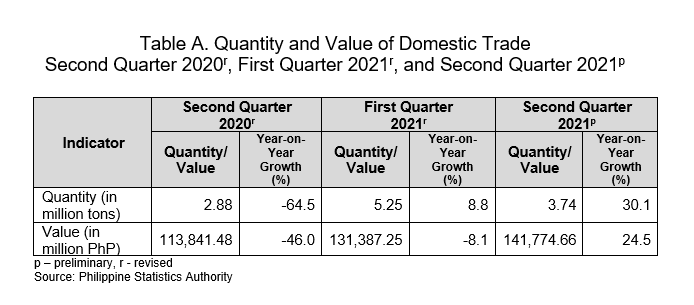
A. Quantity
1. Quantity of domestic trade increased
The total quantity of domestic trade in the second quarter of 2021 was recorded at 3.74 million tons. This represents an annual increment of 30.1 percent, from an 8.8 percent annual increase in the previous quarter. In the same quarter of 2020, the annual decline was faster at -64.5 percent. Almost all (99.9%) of the commodities were traded through water (coastwise), while the rest were traded through air. (Figure 1 and Table A)
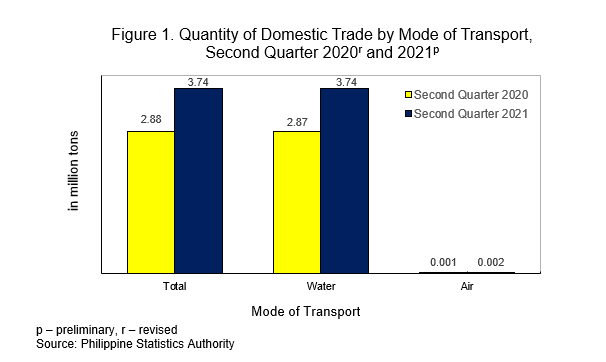
2. Manufactured goods classified chiefly by material topped in terms of quantity of domestic trade
By commodity section, manufactured goods classified chiefly by material led in terms of quantity of domestic trade in the second quarter of 2021 with 0.95 million tons or a share of 25.4 percent to the total. This was followed by food and live animals with 0.84 million tons (22.5%) and commodities and transactions not elsewhere classified with 0.49 million tons (13.1%). (Figure 2 and Table 1)
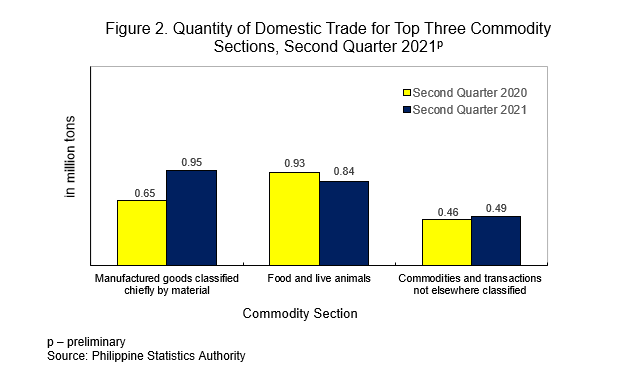
3. Central Visayas led in terms quantity of traded commodities
By region, Central Visayas (Region VII) registered the highest quantity of traded commodities with 1.09 million tons or 29.1 percent share to the total in the second quarter of 2021. This was followed by Northern Mindanao (Region X) with a quantity of 0.58 million tons (15.6%) and Bicol Region (Region V) with 0.46 million tons (12.3%). (Figure 3 and Table 2)
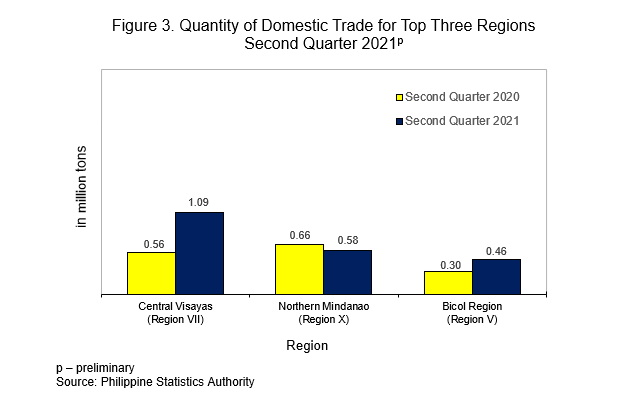
B. Value
1. Value of domestic trade increased
Domestic trade value is the outflow value which refers to the value of commodities that goes out from a specified region/province to another region/province.
The total value of domestic trade in the second quarter of 2021 amounted to PhP 141.77 billion. This indicates an expansion of 24.5 percent from the PhP 113.84 billion value of domestic trade in the same period of 2020.
By mode of transport, the total value of traded commodities through water accounted for almost all (99.98%) of the total commodities that flow within the country, while the remaining were traded through air. (Figure 4 and Table 1)
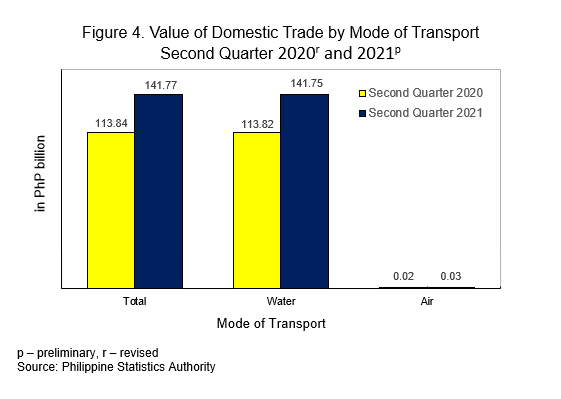
2. Machinery and transport equipment registered the highest value of traded commodities
Machinery and transport equipment topped in terms of the value of traded commodities with PhP 43.83 billion or 30.9 percent share to the total. This was followed by food and live animals valued at PhP 33.63 billion (23.7%), and manufactured goods classified chiefly by material which amounted to PhP 32.39 billion (22.8%). (Figure 5 and Table 1)
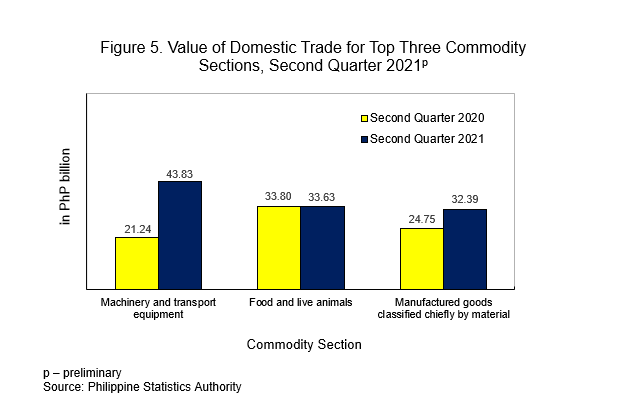
3. Eastern Visayas registered the highest value of traded commodities
Among the regions, Eastern Visayas (Region VIII) ranked first with a total value of traded commodities of PhP 28.87 billion or 20.4 percent share to the total in the second quarter of 2021. Northern Mindanao (Region X) came next with traded commodities which amounted to PhP 27.75 billion (19.6%), followed by Western Visayas (Region VI) with PhP 24.44 billion (17.2%). (Figure 6 and Table 2)
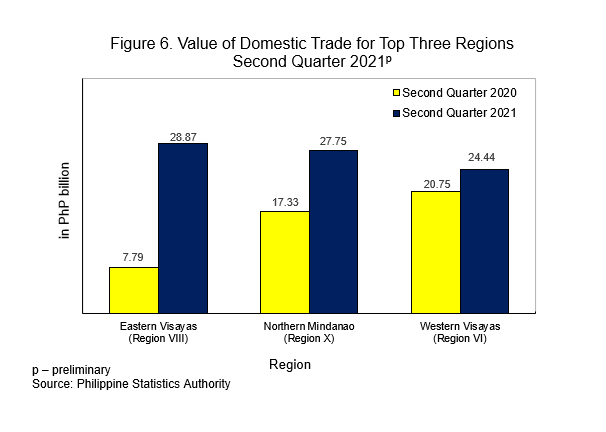
4. Northern Mindanao led in terms of inflow value
Inflow refers to the value of commodities that enters in the specified region/province from other regions/provinces.
By region, Northern Mindanao (Region X) posted the highest inflow value of domestic trade of PhP 40.35 billion or 28.5 percent share to the total in the second quarter of 2021. This was followed by Central Visayas (Region VII) with inflow value of PhP 24.65 billion (17.4%) and Western Visayas (Region VI) with PhP 20.96 billion (14.8%). On the other hand, Cagayan Valley (Region II) had the lowest inflow value which amounted to PhP 2.8 million. (Figure 7 and Table 3)
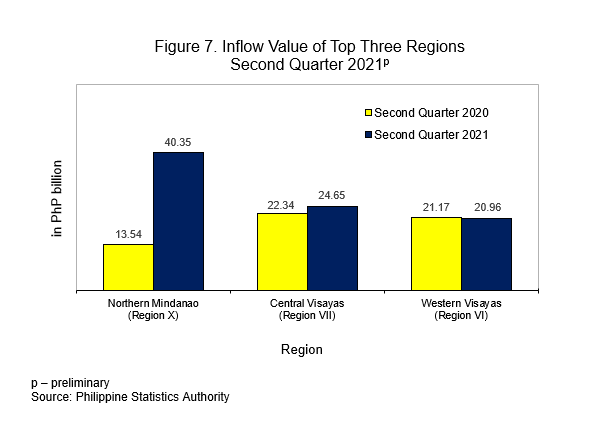
5. Eastern Visayas logged the highest trade balance
The trade balance is the difference between the outflow value and inflow value.
The top three regions with favorable (positive) trade balances in the second quarter of 2021 were the following:
a. Eastern Visayas (Region VIII), PhP 15.65 billion;
b. NCR, PhP 7.17 billion; and
c. Bicol Region (Region V), PhP 4.88 billion.
(Figure 8 and Table 3)
On the other hand, top three regions with unfavorable (negative) trade balances in the second quarter of 2021 were the following:
a. Northern Mindanao (Region X), PhP -12.59 billion;
b. Central Visayas (Region VII), PhP -6.29 billion; and
c. CALABARZON (Region IVA), PhP -5.37 billion. (Table 3)
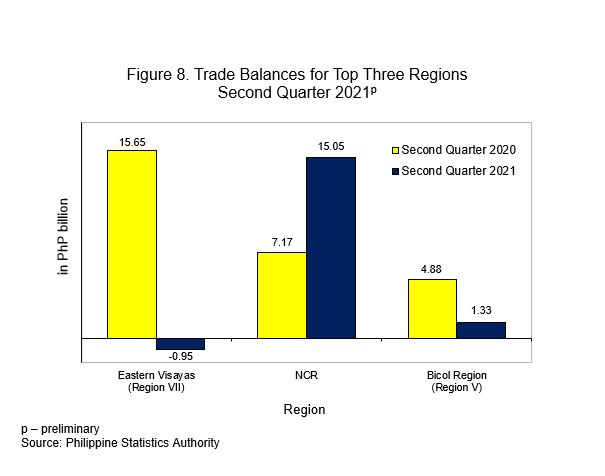
DENNIS S. MAPA, Ph.D.
Undersecretary
National Statistician and Civil Registrar General
EXPLANATORY NOTES
Overview
Commodity flow or domestic trade statistics is a compilation of data on commodities carried through air, rail, and water transport systems within a given country. However, in the Philippines, the Philippine Statistics Authority (PSA) compiles domestic trade carried through air and water only.
Data on the inflow and outflow of commodities in the different regions of the country are used to construct inter-regional and inter-industry relational tables. These serve as bases in the formulation and implementation of various regional development programs like countryside development and port planning.
The 1993 Philippine Standard Commodity Classification (PSCC), Revision 2 is used to classify the commodities at the 5-digit level (item) for coastwise statistics and 3-digit level (group) for air statistics.
Scope and Coverage
Domestic trade statistics contained in this report pertain to the flow of goods through airports and seaports in the country, whether for government or private use, or commercial purposes. It covers air trade and coastwise trade.
Goods and/or commodities that are excluded in the compilation of domestic data are the following:
a. Goods transported by vessels of the Philippine Navy;
b. Fish and other marine products unloaded in fishing ports;
c. Fish and other marine products landed directly from the sea; and
d. Logistic goods intended for the vessel and the crew.
Sources of Data
The source documents for the coastwise trade statistics are the coasting manifests and coastwise passenger manifests from major ports and other active seaports listed by the Philippine Ports Authority (PPA) all over the country. Air waybills, on the other hand, are the source documents for air trade statistics issued by Philippine Airlines to every consignee.
Processing
All copies of documents are compiled and processed by the Provincial Statistical Offices (PSO) of PSA. The PSO submits monthly data files to the Central Office (CO) not later than one month after the reference month.
Final data review of the data files, generation of statistical tables, and preparation of Special Releases are done at the CO, particularly in the Trade Statistics Division (TSD) of the Economic Sector Statistics Service.
Dissemination
Quarterly Special Releases on domestic trade statistics are published two months after the reference quarter at the PSA website (www.psa.gov.ph) and at the OpenSTAT (openstat.psa.gov.ph). Revised data which incorporate information from records received after the set quarterly deadline are included in the next release.
Data requests on domestic trade statistics are available at TSD with telephone number (02) 8376-19-75 and email address tsd.staff@psa.gov.ph.
